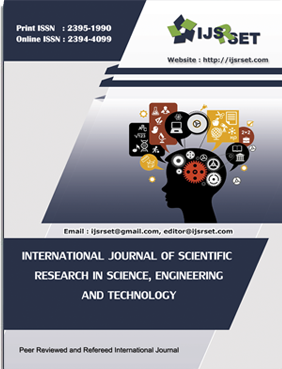Characterization, Comparative Assessment and Antibacterial Potential of Copper(II) Soya Complexes against Staphylococcus Aureus
DOI:
https://doi.org/10.32628/IJSRSET2411245Keywords:
Copper (II) Soya Complexes, Photocatalytic Degradation, Staphylococcus Aureus, Antibacterial Activity, Inhibition Zone, Kirby-Bauer Disc Diffusion MethodAbstract
Copper(II) soap complexes have been proven their activity against bacteria very effectively. Herein, the influence of biophysical and biomechanical parameters on the activity of Copper(II) soya thiourea complex was evaluated. To this aim, liquid as well as solid growth media were developed by Kirby-Bauer disc diffusion method. The antibacterial activity of Copper(II) soya thiourea complex against the Gram-positive bacterium Staphylococcus aureus was assessed in various concentration of Copper(II) Soya complexes. Copper (II) Soya complexes also resist bacterial growth at higher concentration. This review provides a board overview of Staphylococcus aureus with an emphasis on the Copper(II) soya thiourea complex
📊 Article Downloads
References
P. J. Kuhn, Doorknobs: a source of nosocomial infection? Diagnostic Medicine,1983.
T. E. Cooney, Bactericidal Activity of Copper and NonCopper Paints, Infect.Control Hosp. Epidemiol, 1995, 16(8), 444-450. doi: 10.1086/648361. DOI: https://doi.org/10.1086/648361
G. Borkow, Gabbay, Putting Copper into action: Copper‐impregnated products with potent biocidal activities,FASEB Journal, 2004, 18(14), 1728-1730. DOI: https://doi.org/10.1096/fj.04-2029fje
A. R. Manley ,The effects of Copper on the behaviour, respiration, filtration and ventilation activity of Mytilusedulis, JMBAUK, 1983,63(1),205-222. doi: https://doi.org/10.1017/S0025315400049900 DOI: https://doi.org/10.1017/S0025315400049900
D. T. Minkel,C.H.Chanstier, D. H. Petering, Reactions of 3-Ethoxy-2-oxobutyraldehyde Bis(N4-dimethylthiosemicarbazonato)- Zinc(II) withtumor cells andmitochondria, MolecularPharmacology, 1976, 12( 6),1036–1044.
V. Rajendiran, R. Karthik, M. Palaniandavar,Mixedligand Copper(II)-phenolate complexes: effect of coligand on enhanced DNA and protein binding, DNA cleavage, and anticancer activity, Inorganic Chemistry, 2007,46(20), 8208–8221. DOI: https://doi.org/10.1021/ic700755p
A. E. Liberta , D. X. West, Antifungal and antitumor activity of heterocyclicthiosemicarbazones and their metal complexes:current status, Biometals, 1992, 5( 2), 121–126. DOI: https://doi.org/10.1007/BF01062223
C. Marzano, M. Pellei, F. Tisato, C. Santini, Copper complexes as anticancer agents, Anti-Cancer Agents in Medicinal Chemistry, 2009, 9( 2), 185–211. DOI: https://doi.org/10.2174/187152009787313837
Y. Harinath, D. H. K. Reddy, B. N. Kumar, C. Apparao, K. Seshaiah, Synthesis, spectral characterization and antioxidant activity studies of a bidentate Schiff base, 5-methyl thiophene-2- carboxaldehyde-carbohydrazoneand its Cd(II), Cu(II), Ni(II) and Zn(II) complexes, SpectrochimicaActa Part A: Molecular and Biomolecular Spectroscopy, 2013, 101, 264–272. DOI: https://doi.org/10.1016/j.saa.2012.09.085
J. Sheikh,H. Juneja, V. Ingle, P. Ali, T. B.Hadda, Synthesis and in vitro biology of Co(II), Ni(II), Cu(II) and Zinc(II) complexes of functionalizedbeta-diketone bearing energy buriedpotential antibacterial and antiviral O,O pharmacophore sites, J. Saudi Chem. Soc., 2013, 17( 3), 269–276. DOI: https://doi.org/10.1016/j.jscs.2011.04.004
S. M. Saadeh, Synthesis, characterization and biological properties of Co(II), Ni(II), Cu(II) and Zn(II) complexes with an SNO functionalized ligand, Arab. J. Chem., 2013, 6(2), 191–196. DOI: https://doi.org/10.1016/j.arabjc.2010.10.002
Z. H. Zhao, Y. Sakagami ,T.Osaka, Toxicity of hydrogen peroxide produced by electroplated coatings to pathogenic bacteria. Can. J. Microbiol.,1998, 44, 441-447. DOI: https://doi.org/10.1139/w98-030
Z. H. Chohan, H. Pervez, A. Rauf, A. Scozzafava, C. T. Supuran, Antibacterial Co (II), Cu (II), Ni (II) and Zn (II) complexes of thiadiazole derived furanyl, thiophenyl and pyrrolyl Schiff bases, Enzyme Inhib. Med. Chem.,2002, 17, 117-122. DOI: https://doi.org/10.1080/14756360290024218
D. K. Sau, R. J. Butcher, S. Chaudhuri, N. Saha,Synthesis and spectroscopic characterization of new cobalt(III) complexes with 5-methyl-3formylpyrazole 3- hexamethyleneiminyl thiosemicarbazone (HMPz3Hex): X-ray crystallographic identification of HMPz3Hex about the azomethine double bond of the ligand on complexation with cobalt(III), Polyhedron,2004,23(1),5-14. DOI: https://doi.org/10.1016/j.poly.2003.09.007
V.Sukhadia , R. Sharma,A. Meena, Study of Photocatalytic degradation, Kinetics and Microbial Activities of Copper (II) Soya Urea Complex in Non Aqueous Media. Letters in Organic Chemistry, 2021, 18, 912-923. DOI: https://doi.org/10.2174/1570178617999200711175559
D F Brown, D. Kothari, Comparison of antibiotic discs from different sources, J. Clin. Pathol. 1975, 28 (10), 779–783. doi:10.1136/jcp.28.10.779. PMC 475859. PMID 1214010 DOI: https://doi.org/10.1136/jcp.28.10.779
R. Subramaniyam, F. Aafreen , R.R. Jonnalagadda, U.N. Balachandran , Antibacterial activity of Copper(II) complexes against Staphylococcus aureus, RSC Adv., 2014, 4, 32004–32012. DOI: https://doi.org/10.1039/C4RA03241A
S. Khan, R.Sharma, A.K. Sharma, Antifungal Activities of Copper Surfactants derived from Neem (Azadirecta indica) and Karanj (Pongamiapinnata) Oils: A Pharmaceutical Application, Glob J Pharmaceu Sci. ,2017, 3(4), 555616. DOI: https://doi.org/10.19080/GJPPS.2017.03.555616
S. Chandra , D. Jain , A. K. Sharma ,P. Sharma, Coordination Modes of a Schiff Base Pentadentate Derivative of 4- Aminoantipyrine with Cobalt(II), Nickel(II) and Copper(II) Metal Ions: Synthesis, Spectroscopic andAntimicrobial Studies , Molecules ,2009, 14, 1 74-190. DOI: https://doi.org/10.3390/molecules14010174
H.H. Horowitz, A. Metzger, New analysis of thermogravimetric traces. G. Anal. Chem., 1963, 35(10), 1464-1468. http://dx.doi.org/10.1021/ac60203a013 DOI: https://doi.org/10.1021/ac60203a013
A. Broido, A simple, sensitive graphical method of treating thermogravimetric analysis data, J. Polymer Sci., Part B-2, 1969, 7(10), 1761-1773. http://dx.doi.org/10.1002/pol.1969.160071012 DOI: https://doi.org/10.1002/pol.1969.160071012
R. Bhutra, R. Sharma, A. K. Sharma, AntimicrobialStudies and Characterization of Copper SurfactantsDerived from Various Oils Treated at High Temperaturesby P.D.A. Technique. Open Pharm. Sci. J.,2018, 5, 36. http://dx.doi.org/10.2174/1874844901805010036 DOI: https://doi.org/10.2174/1874844901805010036
N. Mathur, N.Jain, A. K. Sharma, Biocidal activities of substituted Benzothiazole of Copper surfactants over candida albicans & trichoderma harziamunon on muller hinton agar. Open Pharm. Sci. J., 2018, 5, 24-35. http://dx.doi.org/10.2174/1874844901805010024 DOI: https://doi.org/10.2174/1874844901805010024
P.Tank, R.Sharma, A. K. Sharma, A Pharmaceutical Approach & Antifungal Activities of Copper Soaps with their N & S Donor Complexes Derived from Mustard and Soya bean Oils, Glob J Pharmaceu Sci. 2017,3(4), 555619. doi: 10.19080/GJPPS.2017.03.555619 DOI: https://doi.org/10.19080/GJPPS.2017.03.555619
Downloads
Published
Issue
Section
License
Copyright (c) 2024 International Journal of Scientific Research in Science, Engineering and Technology

This work is licensed under a Creative Commons Attribution 4.0 International License.




